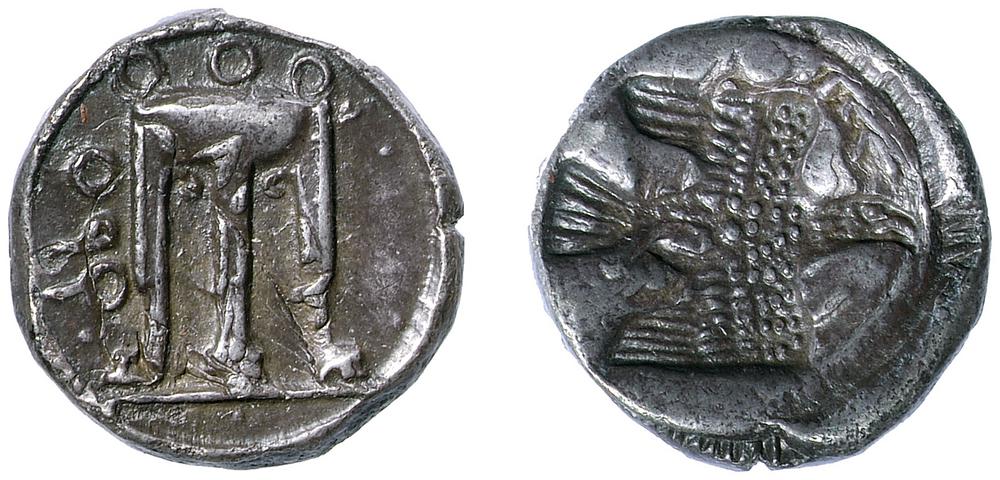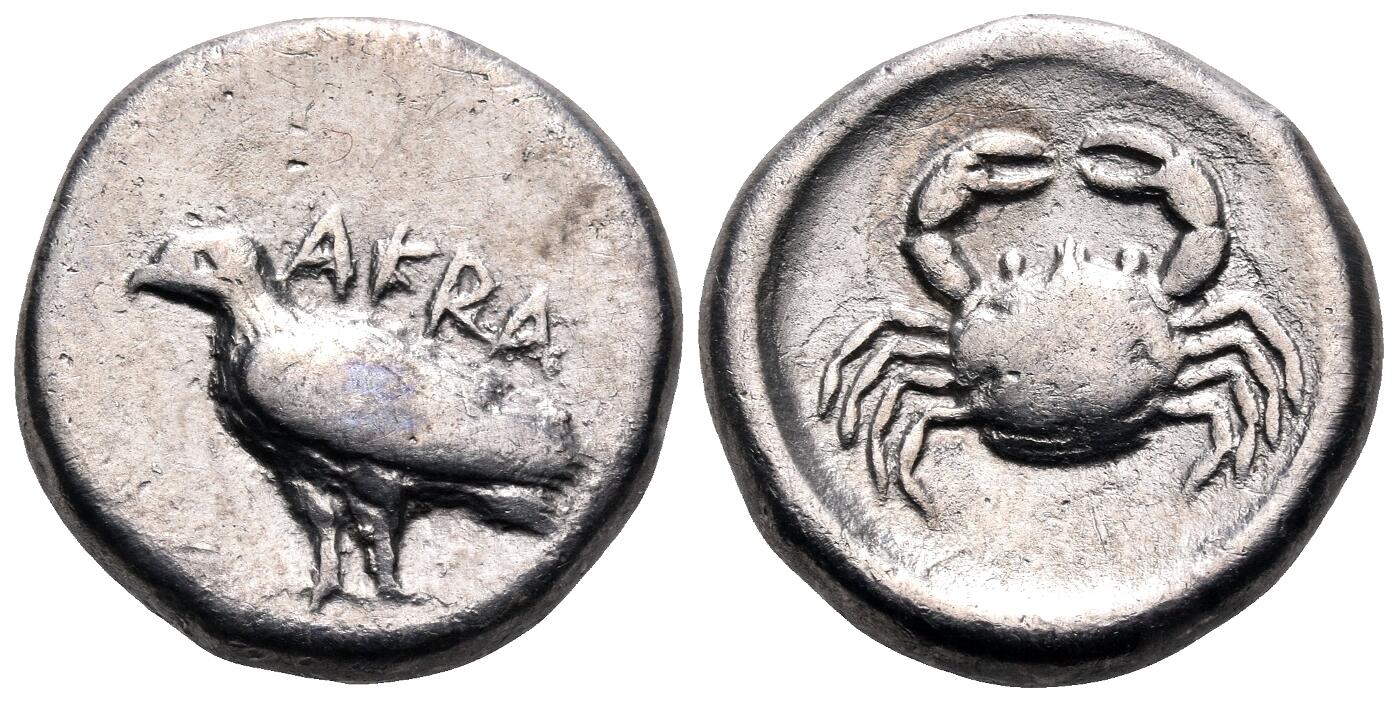2266 - Croton (nomos tripod/eagle) over Agrigentum (eagle/crab) (London, BM, 1918-2-4.31)
From SILVER
(Redirected from SO 172 - Croton over Agrigentum)
430 BCE - 420 BCEϘPO
Images
Overstriking coin

SO 172 - Croton over Agrigentum.jpg [1]
Location/history
| Museum collectionMuseum collection: | London, British Museum, 1918-2-4.31 | |
| Private collection(s)Private collection(s) ᵖ: | John Gorman Ford collection |
Overstriking coin
Description
| ObverseInscription or printing placed on the obverse.: | ϘPO (Greek) Tripod. | ReverseInscription or printing placed on the reverse.: | Eagle flying right. Decorated border. |
Mint and issuing power
| MintIdentifies the place of manufacture or issue of a numismatic object.: | Croton | Ancient regionAncient region. | Bruttium | Modern countryModern country: Italy | AuthorityIdentifies the issuing power. The authority can be "pretended" when the name or the portrait of X is on the coin but he/she was not the issuing power. It can also be "uncertain" when there is no mention of X on the coin but he/she was the issuing power according to the historical sources: |
Chronology
| FromIdentifies the initial date in a range assigned in a numismatic context. 430 BCE toIdentifies the final date in a range assigned in a numismatic context.. 420 BCE | Classical 480-323 BC |
Physical description
| MetalThe physical material (usually metal) from which an object is made.: Silver |
WeightWeight of the numismatic object (in grams). in grams: 8.108.1 g <br />8,100 mg <br /> | DenominationTerm indicating the value of a numismatic object. Examples: tetradrachm, chalkous, denarius.: nomos | |
| StandardStandard.: Achaian | |||
References
| Coin referenceReference of the Coin: | Numismatic Chronicle (1919), pl. I, 3 | Coin series referenceReference to coin series study: | Noe 19571Noe 1957, p. 13-42, pl. V-XIV (group V, p. 28, pl. IX, b), HN Italy2HN Italy, n° 2120, HGC 13HGC 1, n° 1453 |
| Coin series web referenceCoin series web references: | |||
Overstruck type
Description
| ObverseInscription or printing placed on the obverse.: | Eagle | ReverseInscription or printing placed on the reverse.: | Crab |
Mint and issuing power
| MintIdentifies the place of manufacture or issue of a numismatic object. ᵖ: | Agrigentum | Ancient regionAncient region. ᵖ | Sicily | Modern countryModern country: Italy | AuthorityIdentifies the authority in whose name (explicitly or implicitly) a numismatic object was issued. ᵖ: |
Chronology
| FromIdentifies the initial date in a range assigned in a numismatic context. 510 BCE toIdentifies the final date in a range assigned in a numismatic context.. 420 BCE | periodTime period of the numismatic object. |
Physical description
| DenominationTerm indicating the value of a numismatic object. Examples: tetradrachm, chalkous, denarius. ᵖ: | didrachm |
References
| Coin type referenceReference to coin series study ᵖ: | Westermark 20184Westermark 2018 | ||
| Coin series web reference overstruckCoin series web references overstruck: | |||
Additional data
| Frequency of overstrikesFrequency of overstrikes: | frequent | Level of confidenceLevel of confidence of the identification: | sure |
| RemarksRemarks: | |||
References
- ^ Noe, Sydney P. (1957), "Overstrikes in Magna Graecia", American Numismatic Society. Museum Notes 7, p. 13-42, pl. 5-14.
- ^ Rutter N. Keith et alii (eds.) (2001), Historia Numorum Italy, London, xvi, 223 p., 43 pl.
- ^ Hoover, Oliver D. (2018), The Handbook of Greek Coinage Series, Volume 1. Handbook of Coins of Italy and Magna Graecia, Sixth to First Centuries BC., Lancaster-London, 2018, lxi, 527 pages, 23 cm
- ^ Westermark, Ulla (2018), The coinage of Akragas c. 510-406 BC, 2 vol., Uppsala.
